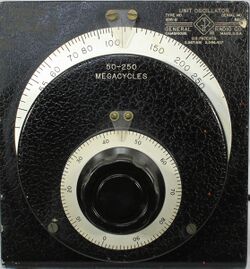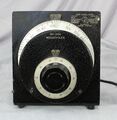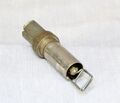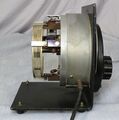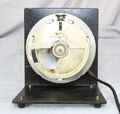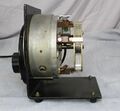1215-B: Difference between revisions
(Created page with "Type '''1215-B Unit Oscillator (50 to 250 Mc)'''. ==Specifications== ==Links== ==Photos== <gallery> </gallery> Category:Oscillators Category:Unit Instruments") |
No edit summary |
||
| Line 1: | Line 1: | ||
{{GR Product | |||
|model=1215-B | |||
|codes=AMEND | |||
|class=oscillators | |||
|summary=Unit Oscillator | |||
|image=GR 1215-B Close-Up.jpg | |||
|caption=General Radio 1215-C Unit Oscillator | |||
|series=1215 | |||
|introduced=1956 | |||
|discontinued=1961 | |||
|designers= | |||
|manuals= | |||
* [[Media:GR 1215-B 50-250 MHz Unit Oscillator 794-B 12_1955.pdf|General Radio 1215-C Unit Oscillator Manual 794-B 1955]] | |||
{{Catalog History}} | |||
}} | |||
The {{Title|General Radio 1215-C Unit Oscillator}} was introduced in {{Catalog O}} and remained available through {{Catalog Q}}. | |||
The Type 1208-B is a general-purpose frequency source covering 50 to 250 MHz. Its an updated version of the 1215-A, most of the improvements are mechanical. It finds use as a generator for bridges, admittance meters, and impedance meters. By the use of the "butterfly" tuning arrangement and lack of sliding contacts, the oscillator is compatible with most sweep devices. In combination with voltmeter combination [[874-VR]] & [[874-VI]] and attenuator [[874-GA]] it provides an accurately known output voltage for receiver testing. | |||
Direct amplitude modulation at audio frequencies is provided by phone jack located on the oscillator housing. With an accessory 1000-P6 Crystal Diode Modulator modulation from 0 to 20 MHz essentially free of fm is possible. | |||
As a unit oscillator, the 1215-B requires an external power supply, type 1203-B is recommended. | |||
==Specifications== | ==Specifications== | ||
* '''Frequency Range:''' 50-250 MHz | |||
* '''Frequency Calibration Accuracy:''' 1% at no load | |||
* '''Warm-up Frequency Drift:''' 0.4% | |||
* '''Output Power:''' 80 mW into a 50-ohm load | |||
==Links== | ==Links== | ||
* [[Media:GR Exp 1215-A 01_1953.pdf|Experimenter October 1953 describing Type 1215-A]] | |||
* [[Media:GR Exp 1215-B 04_1955.pdf|Experimenter October 1955 describing Updated Unit Oscillators]] | |||
* [[Media:2367681 Patent Butterfly tuned circuit.pdf|Patent for the Butterfly Tuning Circuit]] | |||
==Photos== | ==Photos== | ||
<gallery> | <gallery> | ||
GR 1215-B Front.jpg | |||
GR 1215-B Left.jpg | |||
GR 1215-B Rear.jpg | |||
GR 1215-B Right.jpg | |||
GR 1215-B Shield Inside.jpg | |||
GR 1215-B Probe A.jpg | |||
GR 1215-B Probe.jpg | |||
GR 1215-B Inside Left A.jpg | |||
GR 1215-B Inside Left.jpg | |||
GR 1215-B Inside Rear.jpg | |||
GR 1215-B Inside Right A.jpg | |||
GR 1215-B Inside Right.jpg | |||
</gallery> | </gallery> | ||
[[Category:Oscillators]] | [[Category:Oscillators]] | ||
[[Category:Unit Instruments]] | [[Category:Unit Instruments]] | ||
Revision as of 02:57, 28 May 2024
The General Radio 1215-C Unit Oscillator was introduced in Catalog O (1956) and remained available through Catalog Q (1961).
The Type 1208-B is a general-purpose frequency source covering 50 to 250 MHz. Its an updated version of the 1215-A, most of the improvements are mechanical. It finds use as a generator for bridges, admittance meters, and impedance meters. By the use of the "butterfly" tuning arrangement and lack of sliding contacts, the oscillator is compatible with most sweep devices. In combination with voltmeter combination 874-VR & 874-VI and attenuator 874-GA it provides an accurately known output voltage for receiver testing.
Direct amplitude modulation at audio frequencies is provided by phone jack located on the oscillator housing. With an accessory 1000-P6 Crystal Diode Modulator modulation from 0 to 20 MHz essentially free of fm is possible.
As a unit oscillator, the 1215-B requires an external power supply, type 1203-B is recommended.
Specifications
- Frequency Range: 50-250 MHz
- Frequency Calibration Accuracy: 1% at no load
- Warm-up Frequency Drift: 0.4%
- Output Power: 80 mW into a 50-ohm load
Links
- Experimenter October 1953 describing Type 1215-A
- Experimenter October 1955 describing Updated Unit Oscillators
- Patent for the Butterfly Tuning Circuit
